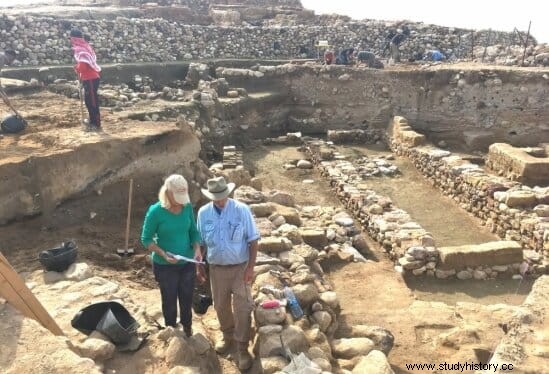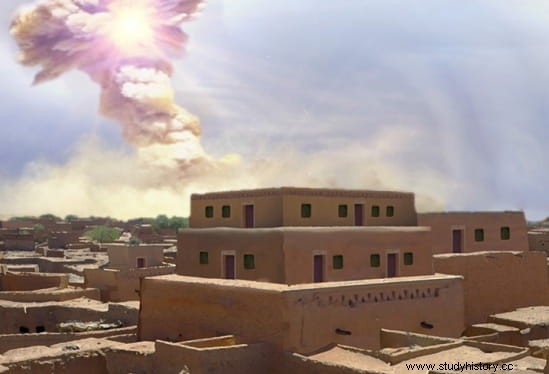In the Middle Bronze Age (about 3,600 years ago, approximately 1650 BC), the city of Tall el-Hammam was prosperous. Situated on high ground in the southern Jordan Valley, northeast of the Dead Sea, the settlement had become the largest continuously occupied Bronze Age city in the southern Levant, dating back a few thousand years. . At that time, it was 10 times larger than Jerusalem and 5 times larger than Jericho.
This is an incredibly important area from a cultural point of view , says James Kennett, professor emeritus of Earth Sciences at the University of Santa Barbara. Much of where the early cultural complexity of humans developed is in this general area.
A favorite haunt of archaeologists and bibliophiles, the mound houses evidence of culture from the Chalcolithic, or Copper Age, all compacted into layers as the strategically important settlement was built, destroyed and rebuilt. over millennia.

But there is a 1.5 meter interval in the Middle Bronze Age II stratum that has caught the interest of some researchers for its highly unusual materials. . In addition to the remains one would expect from destruction by wars and earthquakes, they found pottery shards with the outer surface fused to glass, bubbling mud bricks and partially molten building material, all indications of an anomalously high temperature event, much hotter than the technology of the time could produce.
We saw signs of temperatures above 2,000 degrees Celsius says Kennett, whose research group was then arguing for an older cosmic explosion, some 12,800 years ago, that triggered widespread burning, climate change and animal extinction. The charred and molten materials from Tall el-Hammam were familiar to him, and a group of researchers, including impact scientist Allen West and Kennett, joined Trinity Southwest University biblical scholar Philip J. Silvia to determine what happened in this city 3,650 years ago. Their results are published in the journal Nature Scientific Reports .
There is evidence of a great cosmic outburst, near this city called Tall el-Hammam , Kennett said of an explosion similar to the Tunguska Event, a burst of about 12 megatons that occurred in 1908, when a 56- to 60-meter meteorite passed through Earth's atmosphere over the East Siberian Taiga.
The impact of the explosion on Tall el-Hammam was enough to flatten the city, crushing the palace and surrounding walls and mud-brick structures, according to the document. The distribution of the bones indicated extreme disarticulation and fragmentation of the skeleton in nearby humans .

For Kennett, further evidence of the airburst was found by performing many types of analyzes on soil and critical layer sediments. In the analysis of it appeared tiny spherules rich in iron and silica, as well as molten metals.
I think one of the main discoveries is impact quartz. These are grains of sand that contain cracks that form only under very high pressure Kennett said of one of many lines of evidence pointing to a large explosion near Tall el-Hammam. We have impact quartz in this layer, and that means there were incredible pressures – quartz is one of the hardest minerals; it is very difficult to compact.
The burst, according to the paper, can also explain the abnormally high concentrations of salt found in the destruction layer:an average of 4% in the sediment and up to 25% in some samples.
The salt was ejected due to the high pressures of the impact Kennett said of the meteorite that likely fragmented upon contact with Earth's atmosphere. And it may be that the impact partially hit the Dead Sea, which is rich in salt . The local shores of the Dead Sea are also rich in salt, so the impact could have redistributed those salt crystals far and wide, not only at Tall el-Hammam, but also at nearby Tell es-Sultan (proposed as Biblical Jericho, which also suffered violent destruction around the same time) and Tall-Nimrin (also destroyed at the time).
According to the researchers, the high-salinity soil could have been responsible for the so-called Late Bronze Age breccia. , in which the cities along the lower Jordan Valley were abandoned, reducing the population from tens of thousands of people to a few hundred nomads. Nothing was able to grow on these once fertile lands, forcing people to leave the area for centuries. In the Iron Age, some 600 years after the sudden devastation of the Bronze Age cities, evidence of the repopulation of Tall el-Hammam and nearby communities appears again.
Tall el-Hamman has been the center of an ongoing debate as to whether it could be the biblical city of Sodom, one of the two cities in the Old Testament Book of Genesis that were destroyed by God because of how evil their gods had become. inhabitants . One of the inhabitants, Lot, is saved by two angels who order him not to look back as they flee. Lot's wife, however, stays and turns into a pillar of salt. Meanwhile, fire and brimstone fall from the sky; multiple cities were destroyed; thick smoke rose from the fires; the inhabitants of the city were killed and the crops in the area were destroyed in what seems to be an account of a cosmic impact event. It's a successful connection.
All observations stated in Genesis are consistent with a cosmic outburst , said Kennett, but there is no scientific proof that this destroyed city is really the Sodom of the Old Testament . However, according to the researchers, the catastrophe could have spawned an oral tradition that could have inspired the written account in the Book of Genesis, as well as the biblical account of the burning of Jericho in the Old Testament book of Joshua.
